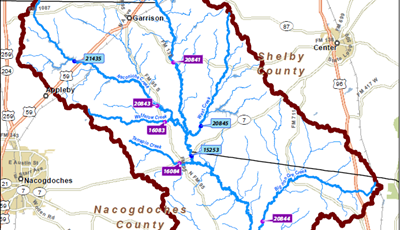The Texas Water Resources Institute (TWRI) has been working with the Attoyac Bayou Watershed Partnership for the past decade to improve water quality, which includes repairing and replacing septic systems.
Emily Monroe, TWRI extension program specialist, said humans have been a major contributor of bacteria in the Attoyac Bayou watershed through failing or nonexistent septic systems.
“Home septic systems are used to treat wastewater before it is dispersed from the property,” Monroe said. “Malfunctioning septic systems can cause bacteria to contaminate the environment.”
Dr. Lucas Gregory, TWRI senior research scientist, said when a septic system fails, there is basically no treatment of the sewage coming out of the house. “The worst-case scenario is there might just be a pipe running out the back of the house into the creek, which is illegal,” he said. “That’s a direct deposition of E. coli into the water.”
Several factors contribute to septic system failures including maintenance neglect and system age. Gregory said septic systems are not a “put it in the ground and leave it thing." Many of the systems are 50-60 years old, possibly having outlived their workable lifespan.
The Attoyac Bayou Watershed Protection Plan (WPP) was completed in 2014 by the partnership, a combination of Angelina & Neches River Authority, Stephen F. Austin State University and TWRI researchers who monitor and evaluate water quality, along with local agricultural producers, city and county government staff, landowners and others interested in protecting the bayou.
Monroe said efforts have been underway to secure financial and technical assistance to implement portions of the plan and improve water quality across the watershed.
“A goal of the partnership was to reduce the number of failing septic systems in the watershed,” she said. “There are enough funds on the OSSF continuation project for at least 15 systems.”
Monroe said in a previous round of funding for the Attoyac Bayou watershed residential septic system program, 23 systems were repaired or replaced.
She said up to 100% of funding for repairing or replacing septic systems is available to residents depending on their income.
Homeowners should contact Pineywoods Resource Conservation and Development at 936-568-0414 or pineywoodsrcd@att.net to find out how they can receive financial assistance or for answers to any questions.
The partnership is supported by TWRI in collaboration with the Angelina & Neches River Authority, Stephen F. Austin State University, Pineywoods Resource Conservation and Development and the Nacogdoches Soil and Water Conservation District.
For more information about the Attoyac Bayou WPP, visit http://attoyac.tamu.edu/.
For septic system best practices and signs of system failure, read this Septic System Maintenance & Inspection Pocket Guide.
The on-site sewage facility repair and replacement project is managed by TWRI and funded in part through Clean Water Act 319 grant from the Texas Commission on Environmental Quality through the U.S. Environmental Protection Agency.



